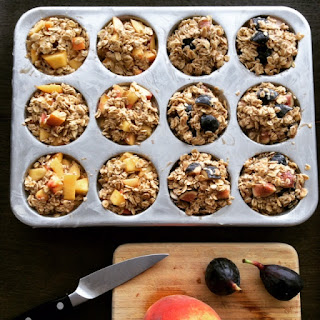Makes 12 baked oatmeal cups.
Ingredients:
- 2 tablespoons butter, melted (plus more for the muffin pan)
- 2 large eggs
- 1 1/2 cups milk (any kind; I used 2%)
- 3 tablespoons brown sugar (lightly packed) (~45 grams) or 1/4 cup honey
- 1 teaspoon vanilla extract
- 3 cups old-fashioned oats (300 grams)
- 1 teaspoon baking powder (5 grams)
- 1 teaspoon ground Saigon cinnamon (2 grams)
- 2 cups fresh raspberries or other fruit (e.g., peaches cut into 1/2 inch cubes; Concord grapes halved and seeded)
Directions:
- Heat oven to 350°F. Grease the wells of a standard 12-well muffin tin well with butter.
- Melt 2 tablespoons of butter and let cool.
- Prepare your fresh fruit.
- Add eggs to a large bowl; whisk. Whisk in butter. Add milk, sugar, and vanilla; whisk until combined.
- Add the oats, baking powder, and cinnamon to the bowl. Stir until combined. The mixture will be soupy.
- Gently mix in your fruit.
- Divide the oatmeal mixture evenly among the muffin wells, ~1/3 cup per well, filling each one just to the top, making sure each well has a similar amount of liquid and filling.
- Bake at 350°F on middle rack until slightly risen, dry on top, and golden-brown, about 30 to 40 minutes. If using a fresh fruit that tends to release liquid while cooking (e.g., peaches), the “muffins” might require a longer baking time, about 45 minutes. Use a toothpick to test for doneness.
- Let the “muffins” cool in the pan on a wire rack for 10 minutes. Run a knife around each muffin, prying gently to remove. Place “muffins” on a rack to cool completely.
 |
| mise en place |
 |
| soupy batter |
 |
| two types of oatmeal cups: peach and fig, ready to be baked |
 |
| peach oatmeal cups, ready to be baked |
Make it your own:
Add a few other ingredients to customize these oat cups to your liking.
- Split the batter in half, adding a different type of fresh fruit to each half.
- Add 1/2 cup unsweetened applesauce or mashed banana to further sweeten the batter (add in step 4).
- Instead of fresh fruit, add 1/2 cup raisins or another dried fruit. For more texture, couple the dried fruit with 1/2 cup chopped nuts, coconut flakes, or chocolate chips (add in step 6). I imagine a batch with dried cherries, coconut flakes, and maybe some mini chocolate chips would be quite a treat.
 |
| baked oatmeal cups: some with raspberries, others with Concord grapes |
The Kitchn recommends:
Storage: Muffins can be kept in an airtight container in the refrigerator for up to 5 days.
Freezing: Individually wrap any muffins you won't eat within
a few days in aluminum foil and freeze. Defrost overnight in the refrigerator.
Once defrosted, they can also be reheated in the microwave for 30 to 45 seconds
if you prefer them warm.
I keep mine on the counter for a day or two, while the rest remained in the fridge or in the freezer. I let those in the fridge come to room temperature on the counter (overnight) before eating them. The texture doesn't suffer at all.
I keep mine on the counter for a day or two, while the rest remained in the fridge or in the freezer. I let those in the fridge come to room temperature on the counter (overnight) before eating them. The texture doesn't suffer at all.
Enjoy!






















